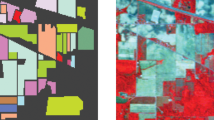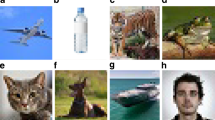Abstract
A methodology based on self-organizing feature maps and indexing techniques for time and memory efficient neural network training and classification of large volumes of remotely sensed data is presented. Results on land-cover classification of multispectral satellite images using two popular neural models show orders of magnitude of speedup with respect to both training and classification times. The generality of the proposed methodology is demonstrated with a dramatic improvement of the classification time of the k-nearest neighbors statistical classifier.
Similar content being viewed by others
References
J.A. Benediktsson, P.H. Swain and O.K. Ersoy,“Neural Network approaches versus statistical methods in classification of multisource remote sensing data”, IEEE Trans. Geoscience and Remote Sensing, Vol. 28, No. 4, pp. 540–552, 1990.
V. Cappellini, A. Chiuderi and S. Fini,“Neural Networks in Remote Sensing Multisensor Data Processing”, Proc. of the 14th EARSeL Symposium, pp. 457–462, Sweden, 1994.
P.D. Heermann and N. Khazenie, “Classification of multispectral remote sensing data using a back-propagation Neural Network”, IEEE Trans. Geoscience and Remote Sensing, Vol. 30, No. 1, pp. 81–88, 1992.
T. Kohonen, Self-Organization and AssociativeMemory, 3rd edn, Springer: Berlin, Heidelberg, New York, 1989.
P. Ienne, P. Thiran and N. Vassilas,“Modified self-organizing feature map algorithms for efficient digital hardware implementation”, IEEE Trans. Neural Networks, Vol. 8, No. 2, pp. 315–330, 1997.
C. Lehmann, M. Viredaz and F. Blayo, “A generic systolic array building block for Neural Networks with on-chip learning”, IEEE Trans. Neural Networks, Vol. 4, No. 3, pp. 400–407, 1993.
S. Haykin, Neural Networks: A ComprehensiveFoundation, Macmillan: Englewood Cliffs, N.J., 1994.
D.E. Rumelhart, G.E. Hinton and R.J. Williams, “Learning Representations by Back Propagating Errors”, Nature, Vol. 323, pp. 533–536, 1986.
F. Fogelman Soulie,“Neural Network architectures and algorithms: A perspective”, in T. Kohonen, K. Makisara, O. Simula, and J. Kangas (eds) Artificial Neural Networks, pp. 605–615, Elsevier: Amsterdam, The Netherlands, 1991.
T. Kohonen, J. Kangas, J. Laaksonen and K. Torkkola, LVQ_PAK: The learning vector quantization program package, Helsinki University of Technology: Espoo, Finland, 1992.
R. Duda and P. Hart,Pattern Classification and Scene Analysis, Wiley: New York, 1973.
Author information
Authors and Affiliations
Corresponding author
Rights and permissions
About this article
Cite this article
Vassilas, N., Charou, E. A New Methodology for Efficient Classification of Multispectral Satellite Images Using Neural Network Techniques. Neural Processing Letters 9, 35–43 (1999). https://doi.org/10.1023/A:1018667811311
Issue Date:
DOI: https://doi.org/10.1023/A:1018667811311




